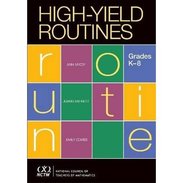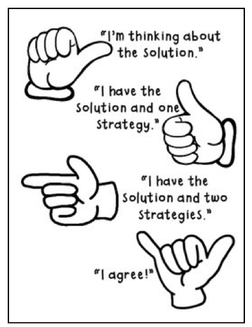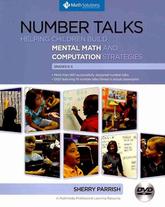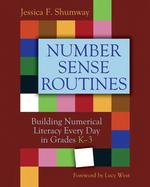Note: For general tips on what Numeracy Routines (e.g. Number Talks, WODB, Estimation 180, Notice/Wonder, Clotheslines, etc.) are, why they are important, and how to begin please click on the Numeracy Routines pages. The following page is specific to Number Talks.
How do I begin to use Number Talks?
To begin, I'd recommend you attend a session in your District on Number Routines where you can engage in the activities as a learner and see them modelled. If that isn't available to you, I would dig into one of the following books and/or the following websites.

High Yield Routines K - 8
Authors Ann McCoy, Joann Barnett, Emily Combs
What can be used for a Number Talk?
Dot cards
Dice
Dominoes
Five and Ten Frames
Rekenreks
Hundreds Frames
Pictures of items
Images of real life arrays - this PPT has many great images - Greg Tang books also have great images that can be used.
Number Strings - Video example of a Grade Four class
Any addition, subtraction, multiplication, or division question
Dice
Dominoes
Five and Ten Frames
Rekenreks
Hundreds Frames
Pictures of items
Images of real life arrays - this PPT has many great images - Greg Tang books also have great images that can be used.
Number Strings - Video example of a Grade Four class
Any addition, subtraction, multiplication, or division question
How to do a Number Talk?

The teacher will present a problem on the board. Students will be given thinking time to solve the problem mental. I typically introduce "Thinking Thumbs" and explain to the students that I do want them to rob their friends of their thinking by blurting out answers. Sherry Parrish feels that this strategy is better than having students raise their hands because she when several hands are in the air, students often stop thinking because they are used to teachers calling on the students with raised hands for the answer. When students are ready, they will indicate by holding up one thumb up to show they have a solution. If the students have more than one way to find the solution they will raise a finger by their thumb. When most students show that they have a solution (e.g., majority of thumbs are up) that is when I ask students to share their thinking. Try not to rush the thinking time as Parrish states "the aim is not to reward speed, but to focus on the thinking about mathematical relationships (Parrish, 2010, Number Talks, pg. 18).
Next I ask students to share their answers. I record all of these, even the incorrect answers. In Number Talks, we use incorrect answers to discover misconceptions students have. Next students are asked to communicate their thinking. What strategies did you use? The teacher will record what the students says and ask if anyone used a different strategy. The rest of the class is actively listening and thinking about the strategies being shared. They are considering and thinking about other students' strategies and checking to see if they make sense. Through this, they are building their own repertoire of strategies. The teacher facilitates the discussion and is responsible for asking guiding questions, such as "How is this strategy similar or different to _______'s strategy?", helping students to make connections.
Next I ask students to share their answers. I record all of these, even the incorrect answers. In Number Talks, we use incorrect answers to discover misconceptions students have. Next students are asked to communicate their thinking. What strategies did you use? The teacher will record what the students says and ask if anyone used a different strategy. The rest of the class is actively listening and thinking about the strategies being shared. They are considering and thinking about other students' strategies and checking to see if they make sense. Through this, they are building their own repertoire of strategies. The teacher facilitates the discussion and is responsible for asking guiding questions, such as "How is this strategy similar or different to _______'s strategy?", helping students to make connections.
Strategies:
Before you provide a question for a Number Talk, you will want to think through all the potential responses your students might provide. You will need to consider how you will capture each student's thinking.
Some potential strategies for addition include:
Some potential strategies for subtraction include:
Some potential strategies for addition include:
- counting all
- counting on
- doubles/near doubles
- making tens
- friendly numbers (e.g., 23 + 48 - Student adds 48 + 2 to get 23 +53 = 73 and then takes away 2 from 71
- compensation (e.g., 8 + 6 The student takes away one from 8 and adds one to 6 to get 7 + 7)
- decomposing numbers by place value (e.g., 12 + 43 becomes (10 + 40 and 2 + 3)
- adding in chunks (e.g., 45 + 28 The student begins by adding 45 + 20 = 65 and then 65 +8 = 73)
Some potential strategies for subtraction include:
- adding up
- decomposing numbers into easy to remove parts e.g., 65 - 32 The student thinks of it as 65 - (10 + 10 + 10 + 2)
- decomposing and subtracting by place value components
An Overview/Tips on Number Talks by Math Pespectives
|
| ||||||||||||
Number Talks - Supporting Websites/Blogposts
Teacher Education By Design (tedd.org/about/TEDD.org) - Created by the University of Washington designed to support teachers
You will need to register to access this free site full of amazing resources. Nested under the "Content Area" of Mathematics you will find links to Quick Image, Number Strings, Mental Math and True/False number talks. In part one, the introduction, you will find everything you need to get you started, such as videos from various grades, and teacher info sheets. In part two, the planning section you will find templates and suggestions. Part three, enact, provides key resources you can use and part four, provides valuable reflection prompts.
You will need to register to access this free site full of amazing resources. Nested under the "Content Area" of Mathematics you will find links to Quick Image, Number Strings, Mental Math and True/False number talks. In part one, the introduction, you will find everything you need to get you started, such as videos from various grades, and teacher info sheets. In part two, the planning section you will find templates and suggestions. Part three, enact, provides key resources you can use and part four, provides valuable reflection prompts.
Number Talk Images - ntimages.weebly.com/ntimages.weebly.com - Curated by Pierre Tranche
This website has a collection of images, including dots, number strings, arrays that can be used for Number Talks.
This website has a collection of images, including dots, number strings, arrays that can be used for Number Talks.
Jo Boaler - Professor of Mathematics at Stanford University - Curator of www.youcubed.org/YouCubed.org
In this six minute www.youcubed.org/resources/jo-teaching-visual-dot-card-number-talk/video you will see Jo Boaler doing a Number Talk with dot images.This is an excellent example of how to do a Number Talk with a whole class.
In this video Grade three students reflect on Number Talks
In this six minute www.youcubed.org/resources/jo-teaching-visual-dot-card-number-talk/video you will see Jo Boaler doing a Number Talk with dot images.This is an excellent example of how to do a Number Talk with a whole class.
In this video Grade three students reflect on Number Talks
The Teaching Channel
This site has many outstanding video examples. In this www.teachingchannel.org/videos/dot-image-lesson-4th-gradelink you will see a Kristen Gray working with Grade Four students using dot cards.
This site has many outstanding video examples. In this www.teachingchannel.org/videos/dot-image-lesson-4th-gradelink you will see a Kristen Gray working with Grade Four students using dot cards.
Janice Novakowski - Richmond School District's Math Consultant Teacher.
Janice has done a lot of work in classrooms with Number Talks and has written about these experiences on her blog. I highly recommend you click on this link to her blogs.sd38.bc.ca/sd38mathandscience/?s=number+talkswebsite to see the many ways Number Talks can be used in various classroom contexts.
Janice has done a lot of work in classrooms with Number Talks and has written about these experiences on her blog. I highly recommend you click on this link to her blogs.sd38.bc.ca/sd38mathandscience/?s=number+talkswebsite to see the many ways Number Talks can be used in various classroom contexts.
Sandra Ball - Inner City Early Learning Helping Teacher in Surrey
Sandra has some excellent resources on her startingwiththebeginning.wordpress.com/number-talks/page, including addition and subtraction strategies and foci for number talks at different grades.
Sandra has some excellent resources on her startingwiththebeginning.wordpress.com/number-talks/page, including addition and subtraction strategies and foci for number talks at different grades.
Key articles
Number Talks Build Numerical Reasoning by Sherry Parrish
| numbertalks_sparrish1.pdf | |
| File Size: | 1116 kb |
| File Type: | |



